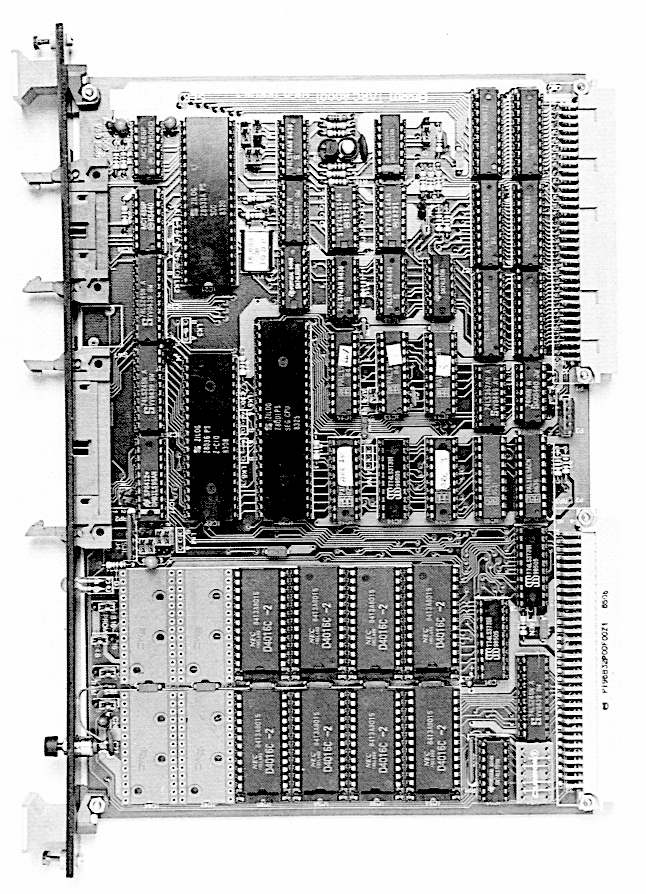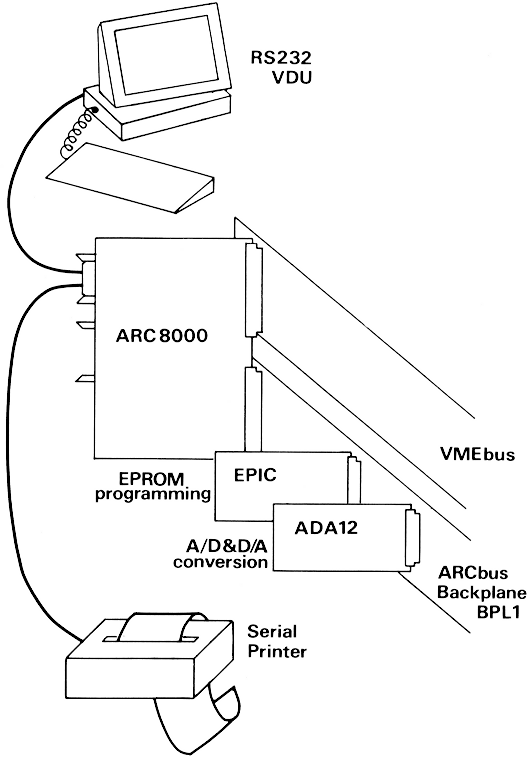VMEbus
VMEbus Introduction
Our VMEbus involvement began in 1982, when we were asked by Zilog UK if we would like to collaborate on the design of a new CPU board using the powerful Z8000 microprocessor. This fitted in well with our development plans, and in 1983 we were marketing the ARC8000 board, which we believe to be the first UK designed VMEbus CPU to be commercially available in the UK. Right from the start the ARC8000 has proved to be a popular CPU in many specialist application areas, particularly in aerospace; many of the leading aircraft manufacturers in Europe use the ARC8000.
VMEbus Technical
VMEbus has its roots in Motorola’s Versabus, and is a good example of a standard which resulted from the efforts of several manufacturers. It was originally designed as a vehicle for the 68000 microprocessor, although the Z8000 interfaces quite easily. The VMEbus specification is available commercially from a number of sources. It has been presented to the IEEE for standardisation, and has the project number P1014. It is at the same stage in the procedure as STEbus.
ARC8000 Z8000 VME CPU
At last you can use a powerful Z8001-based 16/32-bit computer with the latest Zilog peripheral devices. In the ARC8000, Arcom have produced an extremely powerful CPU which can be used either with Arcoms inexpensive range of peripheral boards (the ARC40-series), with new VME products from Arcom or with proprietary VMEbus boards. This multi-purpose board is equipped with many exciting new features and is designed with three application areas in mind:
- As a low-cost single-board computer with on-board RAM, EPROM, serial and parallel I/O
- In industrial control, using I/O boards from the existing Arcom range for A/D and D/A conversion, digital and power I/O, IEEE488 interfacing and EPROM programming.
- As part of a high performance multiprocessing system (multiple processors operating at multiple clock speeds) with the sophisticated VME bus.
Features:
- Z8001 segmented 16-bit processor
- Eight 2 Kbyte (i.e. 16 Kbyte) CMOS static RAM fitted as standard. This is expandable to 64Kbyte onboard in total (using eight 8 Kbyte CMOS static RAM chips)
- Two 4 Kbyte EPROM monitor (four 16 Kbyte EPROMs are the maximum provision)
- Z8030 SCC high-speed serial communications controller
- Dual RS232 serial ports
- Z8036 CIO parallel I/O and counter timers (two 8-bit parallel ports, one 4-bit for handshaking etc.)
- 34-way parallel I/O
- VMEbus timeout (can be disabled)
- VMEbus interface via 96-pin DIN 41612 connector
- ARCbus interface via 64-pin DIN 41612 connector
- Double Eurocard size, 160 × 233 mm

ARC8000
Technical Data
The ARC8000 VMEbus CPU board uses Zilog's powerful Z8001 16/ 32-bit segmented microprocessor. The Z8001 has an 8 megabyte basic address range, a powerful instruction set (including hardware multiply divide), sophisticated interrupt handling and a large register space. It is supported by Zilog's latest high-speed serial and parallel peripheral devices. A range of processor speeds (4, and 6 MHz) are currently available.
VME Bus Features
The VME bus gives you access to an extremely powerful range of computer and modular peripheral boards, each designed for multiple processor operation with a range of clock speeds. The ARC8000V version uses the closely specified VMEbus (the ARC8000V is of the A24 D16 type - which means 24-bit address range and 16-bit data transfers). Of the 16-megabyte potential address space, the Z8001 can address half (8 megabytes). The bus specification allows for an easy upgrade path to 32/32-bit which will shortly become available. The ARC8000V, with an on-board Option 1 bus arbiter, time-out module and VME interrupt handler, can act as a bus master. A system clock option is available on the 4MHz version.
Arc Bus Features
Interfacing with Arcom's complete range of I/O boards is possible by using the second Eurocard connector. This allows immediate system expansion to 16-bit industrial control systems with an established board range. This range includes an EPROM programmer, 8 and 12-bit A/D and D/A, digital I/O with optional optoisolators, power control with solid-state relays, triacs, reed relays and optoisolators, and an IEEE-488 interface. These boards are available ex-stock.
On-board I/O
Zilog's latest peripheral devices are included on the board. The SCC is a sophisticated, very high-speed serial communications controller. It has two independent channels (each with its own Baud-rate generator) and is capable of generating and decoding almost any kind of serial communications protocol - from simple asynchronous to SDLC with automatic zero insertion. Two RS232 interfaces enable you to communicate with most serial peripherals. The CIO is a 20-line parallel I/O device with three counter/timers. It features a variety of handshake modes, pattern-recognition, bit catchers and programmable data direction and polarity. Two 8-bit bidirectional buffers have been added on board for increased drive. In addition, there are four input lines to a TTL buffer for easy interfacing to switches.
Software
Arcom are supporting the CPU with software at various levels. An 8K monitor is supplied in EPROM, allowing memory and register examination and modification, break-point setting, single stepping, EPROM programming and downloading from various host systems.
Power Requirements
5V at approximately 3A; ±12V at approximately 20mA are necessary for the RS232 interfaces. Power is supplied either from a bus connector or via a header on the board.
Mechanical Data
The board is double Eurocard size, 160 × 233 mm. With a 6U 4E front panel.
SAMPLE APPLICATION

 Keith
Keith
Discussions
Become a Hackaday.io Member
Create an account to leave a comment. Already have an account? Log In.